Faculty Research & Honors
Our Physical World
Cornell’s groundbreaking basic and applied research—resulting in innovations in advanced materials, energy, and environment-friendly and other super products—has been a longtime global force. This Cornell research addresses societal needs and advances the economy, and it delivers results that truly matter.
- Boosting Fuel Cell Output at Lower Costs
- Héctor Abruña and Francis DiSalvo, Chemistry and Chemical Biology, and David Muller, Applied and Engineering Physics
- Chess Collaborations
- Cornell High Energy Synchrotron Source
- To Detect Explosives
- William R. Dichtel, Chemistry and Chemical Biology
- Cloaking: A Gap in a Beam of Light
- Alexander Gaeta, Applied and Engineering Physics
- Synchronized by Light
- Michal Lipson, Electrical and Computer Engineering, and Paul McEuen, Physics
- Super Graphene
- Jiwoong Park, Chemistry and Chemical Biology, and David A. Muller, Applied and Engineering Physics
- Improving Battery Performance, Plus
- Richard Robinson, Materials Science and Engineering
- New Power Law of Crackles
- James Sethna, Physics
- Creating Metal Nanostructures
- Ulrich Wiesner, Materials Science and Engineering
Boosting Fuel Cell Output at Lower Costs
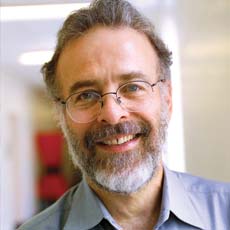
Héctor Abruña and Francis DiSalvo, Chemistry and Chemical Biology, and David Muller, Applied and Engineering Physics, scored a significant advance with a chemical process for improving fuel cell output and cost. The process creates platinum-cobalt nanoparticles with a platinum-enriched shell that shows improved catalytic activity. Abruña says, “It enhances the catalysis and cuts the cost by a factor of five.”
Chess Collaborations

Cornell High Energy Synchrotron Source helped scientists progress in designing the perfect organic semiconductor by spatially mapping the microstructure, texture, grain sizes, and grain orientations of organic semiconductor thin films. The films hold promise for low-cost, flexible electronics—for example, plastic electronics in which an organic material replaces silicon. CHESS’s imaging capabilities also helped other colleagues develop enhanced light-emitting diode displays, which could markedly improve LED displays for LED television and computer screens.
To Detect Explosives
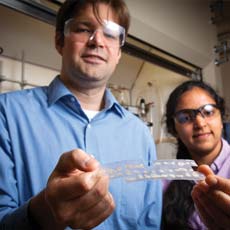
William R. Dichtel, Chemistry and Chemical Biology, and his team created a new polymer that can quickly and safely detect a key ingredient in improvised explosive devices. The polymer could be used in low-cost handheld explosive detectors.
Cloaking: A Gap in a Beam of Light
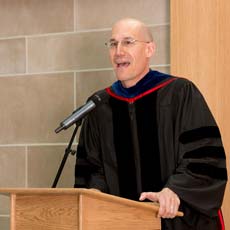
Alexander Gaeta, Applied and Engineering Physics, and his lab demonstrated cloaking on a very small scale in the transport of information by a beam of light. They did it by creating a gap in the beam of light, having the hidden event occur as the gap goes by, then stitching the beam back together. Gaeta’s team calls it a time lens. They can manipulate and focus signals in time, analogous to the way a glass lens focuses light in space. Their technique could improve fiber-optic data transmission and data processing, allowing users to insert an emergency signal without interrupting the main data stream, for example.
Synchronized by Light
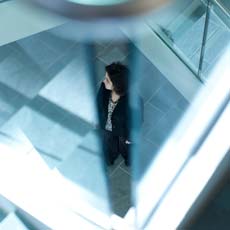
Michal Lipson, Electrical and Computer Engineering, and Paul McEuen, Physics, and their labs demonstrated synchronization at the nanoscale, using light, not mechanics. They showed that two nanomechanical oscillators, suspended only nanometers apart, can talk to each other and synchronize by means of nothing more than light. The researchers demonstrated switching this coupling on and off, as well as tuning the oscillators’ frequencies. The technique has implications for new nanoscale photonic capabilities, such as in tuning oscillator networks for sensing, signal processing, and nanoscale integrated circuits.
Super Graphene

Jiwoong Park, Chemistry and Chemical Biology, and David A. Muller, Applied and Engineering Physics, and their labs used advanced measurement and imaging techniques to show how the stitching between individual crystals of graphene affects how well these carbon monolayers conduct electricity and retain their strength. They found that tighter stitching between grains makes better graphene: more reactive, quick-growth graphene with more small patches, as opposed to slower growth graphene with larger patches.
Park and his colleagues also invented a way to pattern single-atom films of graphene and boron nitride, an insulator, without using a silicon substrate. Integrated circuits—in everything from coffeemakers to computers—are patterned from very thin crystalline silicon. By choosing graphene, Park is pushing thin-film boundaries to the single-atom level, which could lead to the first atomically thin integrated circuit.
Improving Battery Performance, Plus

Richard Robinson, Materials Science and Engineering, developed a method, using nanoparticles, to make additive-free battery electrodes that maintain high conductivity, opening new possibilities for reducing the weight and volume of batteries, while also creating a template system for studying the physics of nanoparticle electrodes.
During another project, the group also developed an inexpensive, environmentally friendly way of synthesizing oxide crystal sheets, only nanometers thick, which have useful properties for electronics and alternative energy applications.
New Power Law of Crackles
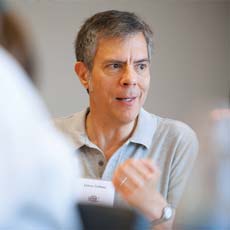
James Sethna, Physics, and research colleagues reported that the crackling behavior of materials under slowly increasing stress, like crumpling pieces of paper—physicists call them avalanches—may have a previously unknown characteristic. The Sethna lab used both theory and experiment to describe this never-before-seen oscillatory behavior of microcrystal plastic bursts at very small scales. Their discovery materialized as a new power law that determines the probability of crackles of different sizes—a theory that could apply to many intermittent phenomena that become oscillatory as relaxation increases, such as earthquakes deep in the Earth’s crust or the low-frequency oscillations of brain waves during sleep.
Creating Metal Nanostructures
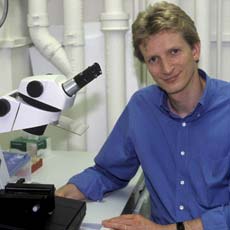
Ulrich Wiesner, Materials Science and Engineering, and his lab developed a technique of making porous metal films with up to a thousand times the electrical conductivity of previous methods. Their technique—the result of several years of experimentation—may lead to creating a wide variety of metal nanostructures for engineering and biomedical applications, including porous metal films for catalysts in fuel cells and electrodes in batteries.
Wiesner’s team and other researchers from Cornell and Memorial Sloan Kettering Cancer Center also created porous nanoparticles with separate compartments that could carry two or more different drugs to the same location, with precise control over the amounts. The technology might also be applied to catalysts used to enhance chemical reactions, allowing two or more catalysts to work in sequence.
